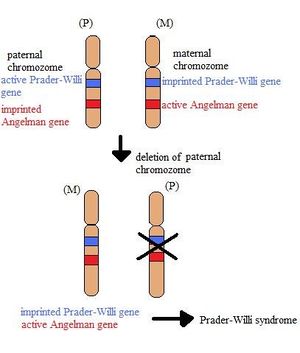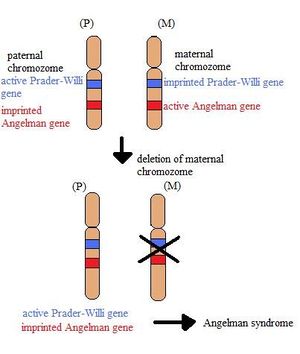Genomic Imprinting
(Redirected from Imprinting)
Genomic imprinting is an epigenetic process where some genes inherited from our parents are not active. Most of our genes have two copies - the first one we get from the mother and the second one from the father. Usually both of them are "turned-on". Often it is not important if you get one copy from each parent or if you get both copies from your mother or your father. Genomic imprinting is an exception. Imprinted genes are functional only when they are inherited from the right parent’s genome.
Imprinted Genes
Most of the genes are not inherited by the rules of the genomic imprinting. The scientists found two main regions of these genes. Their location is:
- on the short arm of chromosome 11
- on the long arm of chromosome 15
We are not able to explain why just these genes. The symptoms of diseases which are connected with genomic imprinting are very different according to the affected chromosome (uniparental disomies - see below).
How do we recognize the right parent’s gene?
The parent of origin is marked. The mark is a methyl group which is connected to the DNA. These methyl groups can help us to recognize which genes were inherited from the mother or the father. Methylation can be used as a marker for the control of gene activity too. Imprinted genes show high level of the methylation.
Uniparental Disomy (UPD)
Uniparental disomy occurs when we receive both copies of the gene from one parent. For example:
- gene A is functional just when we receive it from the mother. Normally we get one from her and the second copy from the father thus gene A has normal function. When you get both copies from the mother - the result is the same. But in case when we receive both copies from the father, the gene is not functinal (it is turned off) and the genome of the child is damaged.
The mistakes can occur during the formation of reproduction cells (eggs and sperm cells) or later - during early fetal time.
The severity of damage depends on the affected areas. As we have already said, most of the genes are not imprinted. If mistake occurs in these regions, nothing happens. Damages of imprinted genes on chromosomes 11 and 15 lead to few syndromes:
Diseases Connected with Imprinting
Prader-Willi Syndrome
- About 2/3 of cases are induced by the loss of paternal chromosome 15 segment (The Prader-Willi/Angelman Critical Region- PWACR; 15q11-13). Physiologically, just genes in the paternal region are functional (the maternal copies are imprinted, i.e. epigenetically silenced) – opposite to Angelman syndrome.
- Typical symptoms: hypotonia, obesity, poor growth, delayed development and higher appetite (hyperphagia – leads to overeating).
- Children have also problems with their learning abilities and behavior. We can also find typical physical features – smaller feet and hands, fair skin, underdeveloped genitals (hypogonadism). Some of the affected patients are infertile.
- Incidence of Prader-Willi syndrome is 1 in 10,000–30,000 people worldwide.
Angelman syndrome
- This syndrome is caused by the loss of function of gene UBE3A - physiologically, just the maternal copy of this gene is functional (the paternal copy is imprinted, i.e. epigenetically silenced). Thus loss of the maternal gene causes this syndrome. The critical genomic region of this disorder is located on chromosome 15 (The Prader-Willi/Angelman Critical Region- PWACR; 15q11-q13). This genetic disorder is connected especially with the nervous system. Children are affected in their early age.
- Typical symptoms: severe intellectual disability and developmental delay, speech problems, ataxia, epilepsy or microcephaly.
- Patients are sometimes called "happy puppets" because of their behavior. They smile frequently, laugh and have flapping movements.
- Incidence of Angelman syndrome is 1 in 12 000 - 20 000 people worldwide.
Beckwith-Wiedemann Syndrome
- This uniparental disomy is connected with changes of methylation on chromosome 11 (11p15). The syndrome affects more parts of the body.
- Typical symptoms: macrosomia (overgrowth or simply gigantism), omphalocele (or related abdominall wall defect), large tongue (macroglossia), kidney abnormalities, hypoglycemia (because of the hyperinsulinisms) and increased risk of tumors (like Wilms tumor) during the childhood. About 20% of patients die in early age because of the complications of these congenital symptoms.
- It is alo called EMG syndrome (exomphalos, macroglossia, gigantism).
- Incidence of Beckwith-Wiedemann sydrome is 1 in 12 000 people worldwide.
- Molecular-genetic diagnostics (inluding the identification of abnormal methylation) is possible.
Links
Related articles
Sources
Bibliography
- KUMAR, ABBAS, FAUSTO, MITCHELL,. Robbins Basic Pathology. 8th edition edition. 2007. ISBN 978-0-8089-2366-4.




